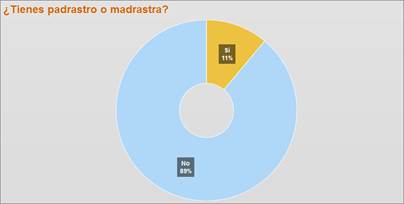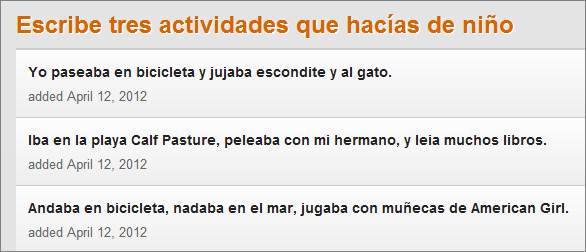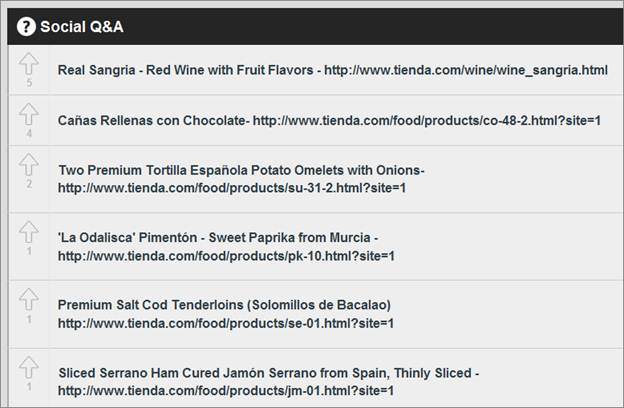Key Takeaways
- This case study explores the use of a classroom response system in Spanish language classes that seemed too small to benefit from the approach.
- A survey of students using GoSoapBox in class found that they enjoyed using the tools provided, from discussions to question and answer sessions, and recommended continued use of the program.
- The instructor liked having everything in one place for easy access during and after the class, including by students, and found the benefits worth paying for.
After reading about GoSoapBox in fall 2011, I decided to participate in the product's beta testing, as I like trying new things that can raise my students' engagement. I wasn't completely sure if a classroom response system would be a good fit for my courses, as they are very small (20 students or less), and the tool seemed to be mostly geared to large courses, where students' opinions and comments can't easily be shared. In any case, from the first time I used it in class, my students liked it, much more than I thought they would. Even in a small course like mine, it proved advantageous. The GoSoapBox classroom response system allows students to become more engaged in the classroom in different ways. Accessible through a computer or mobile device, it offers many tools, including:
- Confusion barometer: Students can click to show they don't understand something. The professor can then see quickly if students do not understand the topic being discussed. This is particularly useful for large classes.
- Social Q&A: Students can post a question at any point during the lecture, and other students (or the instructor) can answer the question. These questions can be voted on and e-mailed to the instructor at the end of class, to ensure that all student questions are answered.
- Discussions: The instructor can also post a question or topic and have students answer them in a similar fashion to a discussion forum.
- Polls: Students answer these anonymously.
- Quizzes: The results can be sent to the instructor later by e-mail.
Once the instructor has set up a "session," participants may enter their names or remain anonymous. Students, though, will not see each other's names at any point.
I have used GoSoapBox for two semesters in several courses, mostly in my first-year Spanish course but also in an advanced conversation course and other advanced courses. Of the tools listed, I don't really use the Confusion Barometer because my courses are small and I can see (more or less) if the students understand the material. I have also used the Quizzes feature very little, as it is something new to GoSoapBox and I didn't have much time to explore it.
Figure 1 shows what one of my sessions might look like. This was a unit about the family.

Figure 1. Screenshot of GoSoapBox in one of my courses
The English translation follows:
Poll: Do you have a stepfather or stepmother?
Discussions: (1) How many brothers and sisters do you have? Do you look like them? Do you get along with them? (2) How many uncles and aunts do you have? Where do they live? Do you have many cousins or just a few? (3) Write three activities you used to do as a child.
I use the polls to start an oral discussion in the class. I used to just do a raising-of-hands question, but there are some topics, like this one, in which students do not want to tell you that they have a step-parent. Also, with raising their hands, I always have a couple of distracted students who would not answer. Now, if I have requested that their names be entered, I can count that as participation, and they thus may be more likely to answer (it is also easier to calculate participation). Figure 2 shows an example poll for "Do you have a stepmother or stepfather?"

Figure 2. Example poll
"Discussions" is the area that I have used the most, and I think students enjoy it. Because it is anonymous for students, they feel comfortable that they won't be judged by their mistakes in Spanish or that they can say more sensitive things (for example "my parents are divorced") without being judged. With this tool, the instructor has the option to let students see other answers as they are completed. I usually prefer that students don't see other people's answers at first (to avoid copy and paste), but after some minutes I change the setting and ask students to start reading the answers and comment about them as well. In my Conversation class, where the questions are a bit more complex, I let students read the answers from the start, and then we choose which would be an example of a good answer. Before using GoSoapBox, there were always some good students who would be fast at answering everything. Now, the best answer often comes from some of the shy students, not just from the fastest.
Figure 3 shows an example in which students have to write three things they used to do as kids.

Figure 3. Discussions area with three things students did as children
As you can see from the example, students are practicing a particular form of the past tense in Spanish, and some of the vocabulary, to talk about childhood activities such as games. What we all liked in the class was that I could comment on whether the verbs were right or wrong, and we could also add more conversation around the answers, such as "Oh, some of you used to play with American Girl dolls. Which one did you have?" or "What kind of books did you used to read when you were a kid?"
The Social Q&A is useful in more advanced courses, or in other circumstances. For example, I used it as a backchannel when our department was presenting the movie "Made in LA" as a university-wide event. Students wrote their own questions or comments while watching the movie using their cell phones, and then the moderators asked them to vote on the questions and to answer the ones that got the most votes, as in figure 4.

Figure 4. Social Q&A question and answers
Another example is from my Beginner's Spanish course. I asked students to look for a food item in the website LaTienda.com (they sell products from Spain), choose a product, and add that product to our session (figure 5). Then, students voted on their favorites.

Figure 5. Social Q&A product entries
I have not used quizzes that much, but they are definitely a great option to have. Figure 6 shows an example of the results from one quiz.

Figure 6. Quiz results
Alternative Programs
GoSoapBox is no longer free (although you can sign for a 30-day free trial). There are license and volume discounts for institutions (discussed individually) or yearly student subscriptions. With the latter model, students pay $10 a year to participate in unlimited classes using GoSoapBox. How does GoSoapBox compare to similar tools that are free?
- Socrative: This student response system can be used with smartphones or computers. I like what they have to offer, and I still use the program, particularly for its "Space Race" option. (Space Race lets you run a quiz like a game. Even though in theory this would appeal more to younger students, my college students loved it.) But, with this tool, you always have one room number, while in GoSoapBox I can create different "sessions" like the example above with my SP102 class, Chapter 8. Students can go back to that link and review everything we did there. Because Socrative is free for now, it is still a good addition to any class.
- TitanPad and Today's Meet: Both of these tools can be used as backchannels. Again, I like them and still use them, but I prefer to have one place where I can accomplish everything and students or I can easily go back to.
- Google Docs: In my view, this is the biggest competitor to GoSoapBox at the moment. I use Google Docs frequently, and it covers most of the things you can do with GoSoapBox, as you can just write Discussions or the Social Q&A in a Google Doc and create quizzes and polls with Forms. You still would not have the Confusion Barometer. For small courses, I think Google Docs is a good alternative. I am not sure it would work with classes larger than 30 collaborators, for example, while GoSoapBox can be used with up to 100 students. I also like having everything in one place, which is more difficult with Google Docs.
I think it is possible to replicate most of the tools in GoSoapBox with other free web tools (at least, the way I use it), but I decided to pay for one more year for the following reasons:
- I like the way everything is organized in GoSoapBox. I can put all activities related to one chapter into a "session" for easy future access, whether it is for my use again next year or for my students to review for exams.
- It's easy to answer any of the students' questions even after the class is over, and everyone can see your responses.
- The "Participation" portion of the grade (if you have one) can be easily calculated.
- After having tried other Web 2.0 tools that are free, I know that "free" may be an advantage, but it can also bring unforeseen problems: The tool can simply disappear, or it can change so much that it's not recognizable. I like the idea of customer support, not only for me but also for my students. I pay for other tools for this reason (like Lingtlanguage or Voicethread).
- I like the team developing GoSoapBox. They have considered my input every time I have had a suggestion. They also keep adding new features. For example, you can now add a picture to a poll, something that will be an excellent addition for languages, or you can have instant polling.
My students love GoSoapBox. Not only they have told me in class and in a questionnaire I prepared for this article (you can see some of their comments in figure 7), but they also mentioned it in my class evaluations at the end of the semester.

Figure 7. Student answers to question about liking GoSoapBox
They also recommended that I keep using it (figure 8).

Figure 8. Student preferences on use of GoSoapBox
Following are some of their comments (from two First-Year Spanish sections and one Conversation course; you can see the rest of the responses here):
"I like the anonymity. There's no pressure or fear of being wrong."
"It's anonymous and we can see what we are doing wrong as well as other people, learning from each other[']s mistakes."
"I like it because it's anonymous and we can see what everyone else is saying. More times than not a few people make the same mistake and without it I don't think we would discuss it as a class and then know the correct answers."
"Yes! [It's] easier to answer the questions and not being worried about whether or not you're wrong. You are more likely to participate and try for a better answer."
"I like soapbox because everyone gets to answer the question and no one is embarrassed for getting things wrong. Plus, you get to see the right way to answer from other people's responses."
"I like that it gives you a way to express ideas without feeling on the spot like when you raise your hand and answer orally. It sparks some really good conversations as well."
Let me know if you have any questions or you have used GoSoapBox for other subjects or with other age groups. I think that the team who created GoSoapBox is one to watch, and I'm very excited to see how I can use their new tools.
© 2012 Pilar Munday. This EDUCAUSE Review Online article (November/December 2012) is licensed under the Creative Commons Attribution-Noncommercial-No Derivative Works 3.0 license.
